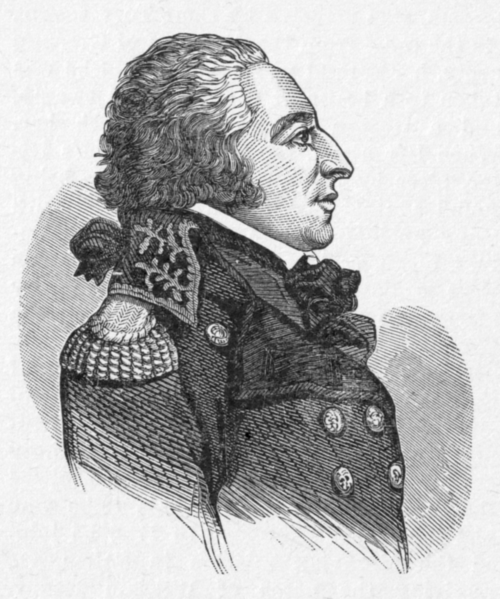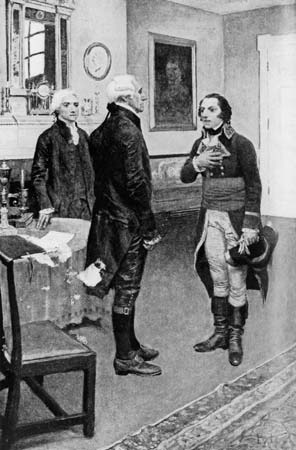<Back to Index>
- Jurist Samuel von Pufendorf, 1632
- Writer Su Shi, 1037
- French Ambassador to the United States Edmond Charles Genêt, 1763
PAGE SPONSOR


Edmond-Charles Genêt (January 8, 1763 – July 14, 1834), also known as Citizen Genêt, was a French ambassador to the United States during the French Revolution.
Genêt was born in Versailles in 1763. He was the ninth child and only son of a French civil servant, Edmond Jacques Genet (September 11, 1726 – September 11, 1781), head clerk in the ministry of foreign affairs. The elder Genet analyzed British naval strength during the Seven Years War and monitored the progress of the American Revolutionary War. Genêt was a prodigy who could read French, English, Italian, Latin, Swedish, and German by the age of 12.
At 18, Genêt was appointed court translator, and in 1788 he was sent to the French embassy in Saint Petersburg. Over time, Genêt became disenchanted with the ancien régime, learning to despise not just the French monarchy but all monarchical systems, including Tsarist Russia under Catherine the Great. In 1792, Catherine declared Genêt persona non grata, calling his presence "not only superfluous but even intolerable." The same year, the Girondists rose to power in France and appointed Genêt to the post of minister to the United States. The Citizen Genêt affair began in 1793 when he was dispatched to the United States to promote American support for France's wars with Spain and Britain. Genêt arrived in Charleston, South Carolina, on the warship Embuscade on April 8. Instead of traveling to the then capital of Philadelphia to present himself to U.S. President George Washington for
accreditation, Genêt stayed in South Carolina. There he was
greeted with enthusiasm by the people of Charleston, who threw a string
of parties in his honor. Genêt's goals in South Carolina were to recruit and arm American privateers which would join French expeditions against the British. He commissioned four privateering ships in total, including the Republicaine, the Anti - George, and the Sapoopnêt. Working with French consul Michel Ange Bernard Mangourit, Genêt organized American volunteers to fight Britain's Spanish allies in Florida.
After raising a militia, Genêt set sail toward Philadelphia,
stopping along the way to marshal support for the French cause and
arriving on May 18. He encouraged Democratic - Republican Societies, but President Washington denounced them and they quickly withered away. His actions endangered American neutrality in the war between France and Britain, which Washington had pointedly declared in his Neutrality Proclamation of
April 22. When Genêt met with Washington, he asked for what
amounted to a suspension of American neutrality. When turned down by Secretary of State Thomas Jefferson and
informed that his actions were unacceptable, Genêt protested.
Meanwhile, Genêt's privateers were capturing British ships, and
his militia was preparing to move against the Spanish. Genêt
continued to defy the wishes of the United States government, capturing
British ships and rearming them as privateers. Washington sent
Genêt an 8,000 word letter of complaint on Jefferson's and
Hamilton's advice – one of the few situations in which the Federalist Alexander Hamilton and the Democratic - Republican Jefferson agreed. Genêt replied obstinately. The Jacobins,
having taken power in France by January 1794, sent an arrest notice
which asked Genêt to come back to France. Genêt, knowing
that he would likely be sent to the guillotine,
asked Washington for asylum. It was Hamilton – Genêt's fiercest
opponent in the cabinet – who convinced Washington to grant him safe
haven in the United States. Genêt moved to New York State and married Cornelia Clinton in 1794, the daughter of New York Governor George Clinton. She died in 1810 and in 1818 Genêt married Martha Brandon Osgood, the daughter of Samuel Osgood, the United States' first Postmaster General. Genêt lived on a farm he called Prospect Hill located in East Greenbush, New York, overlooking the Hudson River. Living the life of a gentleman farmer, he wrote a book about inventions. He died on July 14, 1834 and is buried in the churchyard behind the Greenbush Reformed Church, about two miles east of his farm.